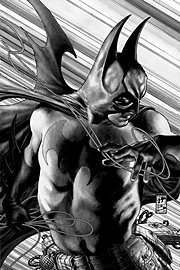Premise: A totalitarian British government is menaced by a brutal vigilante with a flair for the theatric.
I saw
V For Vendetta a couple of nights ago. It was a mostly-faithful adaptation of the comic, and possibly the most courageous film to come from a major Hollywood studio in recent years. Hugo Weaving is the perfect choice to play V, and manages to convey emotions while wearing a full face mask that never changes expression. Natalie Portman is pretty good as Evey, although she did have a little trouble maintaining the English accent. Stephen Rea gives what is sure to be an underrated performance as Inspector Finch, who, for good or for ill, uncovers the truth about V. The Wachowski Brothers did find places to add their signature brand of action, with mixed results.
I had originally planned to discuss the changes in greater detail, but after re-reading (okay,
skimming) the graphic novel, I believe that most of the changes were cosmetic. The comic is a work of greater subtlety than the film, but, as a work of fiction serialized over the course of a decade, it can afford to be. Also, the central characters were made more sympathetic than they appear in the original comic. In Alan Moore and David Lloyd's original story, V was even more ruthless, Evey was an underage prostitute, and Finch's obsession with finding V put tremendous strain on his marriage. Finally, Moore's original comic was a commentary on Thatcher's Britain, and while there are similarities between what happened there in the 80's and what is happening in America now, some changes were necessary for the work to maintain relevance.
Recommended For: people who thought the movie felt a little rushed; people dissatisfied with the Bush Administration; people who believe that history repeats itself.
Not Recommended For: people who enjoyed the film for its action and explosions; neo-cons.



